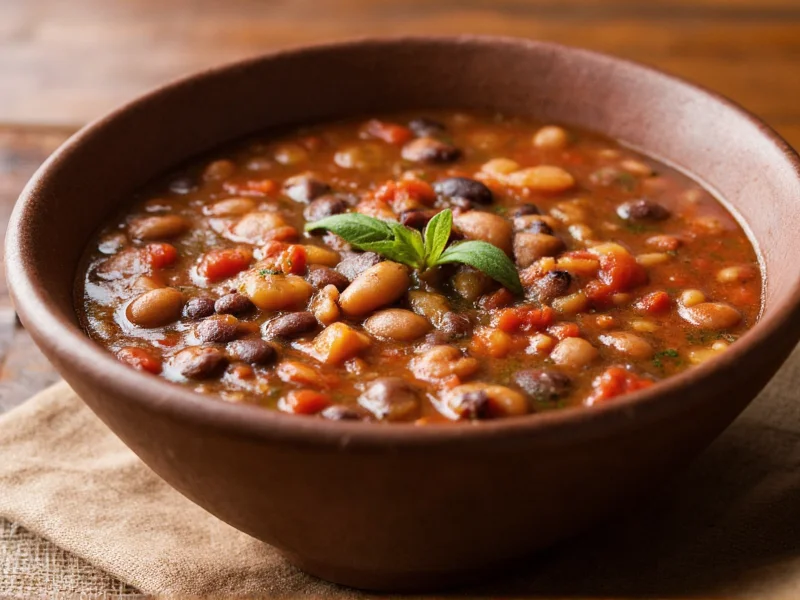The Rich History Behind Black-Eyed Pea Soup
Black-eyed peas have traveled across continents and cultures, originating in West Africa before becoming a staple in Southern American cooking. During the Civil War, these humble legumes sustained communities when other food sources were scarce. The tradition of eating black-eyed pea soup on New Year's Day for prosperity dates back centuries, with each ingredient symbolizing abundance—peas represent coins, greens symbolize paper money, and pork signifies progress.
Nutritional Powerhouse: Health Benefits Explained
One cup of black-eyed peas contains approximately 15 grams of protein and 11 grams of fiber, making this soup an excellent choice for maintaining stable blood sugar levels and supporting digestive health. The natural folate content contributes to heart health, while the iron and potassium support healthy blood pressure. Unlike many canned soups, homemade black-eyed pea soup contains no preservatives and allows you to control sodium levels.
| Cooking Method | Prep Time | Cook Time | Texture Result |
|---|---|---|---|
| Stovetop Traditional | 20 minutes | 1.5-2 hours | Creamy with distinct pea texture |
| Slow Cooker | 15 minutes | 6-8 hours | Extra tender, almost velvety |
| Instant Pot | 15 minutes | 35 minutes | Firm yet fully cooked |
Perfecting Your Black-Eyed Pea Soup Recipe
Start with quality dried black-eyed peas—avoid canned versions for superior texture and flavor control. Soak overnight or use the quick-soak method (boil for 2 minutes, then rest for 1 hour). The flavor foundation comes from the "holy trinity" of Southern cooking: onions, celery, and bell peppers sautéed in olive oil until translucent. Add garlic during the last minute to prevent burning.
For authentic southern style black-eyed pea soup, include a smoked ham hock or turkey neck. Vegetarian cooks can achieve similar depth with smoked paprika and a piece of kombu seaweed. Add soaked peas to your aromatic base with vegetable or chicken broth, bay leaves, and a splash of apple cider vinegar. Simmer uncovered for 45-90 minutes until peas are tender but not mushy.
Customizing Your Soup for Different Diets
Creating a satisfying vegetarian black-eyed pea soup requires thoughtful substitutions. Replace meat-based broths with mushroom or vegetable stock enhanced with nutritional yeast. For vegan preparation, ensure all ingredients align with plant-based requirements while maintaining rich flavor through umami-rich additions like sun-dried tomatoes or liquid smoke.
Those following a low-sodium diet can prepare black-eyed pea soup without added salt by maximizing herbs and spices. Try adding fresh thyme, rosemary, and a touch of cayenne for complexity without compromising health goals. For gluten-free preparation, verify all broth ingredients and avoid thickening with flour.
Pro Tips for Exceptional Results
The secret to creamy black-eyed pea soup without dairy lies in the cooking technique. Reserve one cup of cooked peas, blend until smooth, then stir back into the pot. This natural thickening method enhances texture while maintaining the soup's integrity. Always add acidic ingredients like tomatoes or vinegar near the end of cooking to prevent peas from becoming tough.
For the best flavor development, prepare black-eyed pea soup a day ahead. The flavors meld beautifully overnight, and reheating often improves the overall taste. When storing leftovers, keep broth and peas together—separating them causes the peas to absorb too much liquid and become dry.
Serving Suggestions and Pairings
Traditional accompaniments for southern style black-eyed pea soup include cornbread for dipping and collard greens for a complete meal. A squeeze of fresh lemon just before serving brightens the flavors. For contemporary presentations, top with chopped fresh parsley, a drizzle of good olive oil, or a dollop of plain yogurt.
When serving black-eyed pea soup for New Year's, consider the symbolic presentation—place a coin at the bottom of one bowl for extra luck. This tradition connects modern meals with centuries of cultural heritage while adding a playful element to holiday celebrations.
Troubleshooting Common Issues
If your black-eyed pea soup turns out too thin, create a slurry with cornstarch and cold water, then stir into the simmering soup. For overly thick soup, gradually add warm broth until reaching your desired consistency. Hard peas usually indicate insufficient cooking time or using old dried beans—always check expiration dates on dried goods.
When preparing black-eyed pea soup in advance, remember that peas continue absorbing liquid as they sit. Plan to add additional broth when reheating to restore perfect texture. For freezer-friendly preparation, undercook peas slightly as they'll soften further during thawing and reheating.
Frequently Asked Questions
Do I need to soak black-eyed peas before making soup?
Soaking black-eyed peas isn't strictly necessary but improves texture and reduces cooking time. For quick preparation, use the quick-soak method: boil for 2 minutes, remove from heat, cover, and let sit for 1 hour. Without soaking, expect cooking time to increase by 30-45 minutes. Some modern recipes skip soaking entirely, especially when using an Instant Pot.
How can I make black-eyed pea soup without meat?
Create flavorful vegetarian black-eyed pea soup by using smoked paprika, liquid smoke, or chipotle peppers in adobo sauce to mimic meaty depth. Sauté mushrooms until deeply browned to add umami richness. Kombu seaweed during cooking provides subtle oceanic notes that enhance the overall flavor profile without overpowering the dish.
Why do people eat black-eyed pea soup on New Year's?
Black-eyed pea soup on New Year's Day symbolizes prosperity in Southern US tradition, with peas representing coins. This custom has roots in both African and European folklore, where legumes symbolized good fortune. Eating greens (like collards) alongside the soup represents paper money, while pork (often in the soup) signifies progress since pigs root forward.
Can I freeze black-eyed pea soup successfully?
Yes, black-eyed pea soup freezes exceptionally well for up to 6 months. Cool completely before transferring to airtight containers, leaving 1-inch headspace for expansion. For best results, slightly undercook the peas before freezing. When reheating, add extra broth as the peas will absorb liquid during storage. Avoid freezing soup with dairy additions—add those fresh when serving.











 浙公网安备
33010002000092号
浙公网安备
33010002000092号 浙B2-20120091-4
浙B2-20120091-4